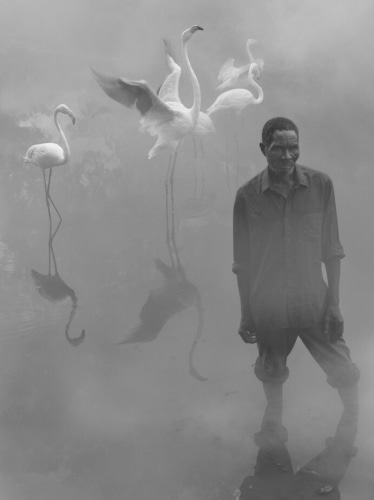
As catastrophic wildfires, deadly flooding, record-breaking heat domes and drought inundate our world here and abroad, it is not hard to see why British photographer Nick Brandt is inspired to tell the stories of the people and animals most affected by the deteriorating conditions of our planet.
Brandt’s new book, “The Day May Break” (Hatje Cantz, 2021) is timely, publishing shortly after a landmark United Nations report stated that there was no doubt humans were affecting climate change, calling the findings “a code red for humanity.”
Brandt has documented the environmental degradation of Africa since 2001 and has produced several series of books and exhibits showing this, such as “Inherit the Dust” and “This Empty World.” As extreme weather patterns and events have continued to escalate around the world, it became clear to Brandt that he needed to photograph the animals and the people affected by them.
Brandt’s hauntingly beautiful, almost surreal portraits of people and animals made in Kenya and Zimbabwe suggest just how intertwined their struggle for survival is.
Brandt told In sight, “The fog in the photos is symbolic of the natural world that we once knew rapidly disappearing from view. The animals and humans are photographed together in this fog, in the same frame, because simply, we are all denizens of the same home: our actually very small planet.”
In the photos Brandt captures on his medium-format digital camera, the subjects seem to bear similar expressions and emotions; even their postures are sometimes the same.
Brandt describes just how this all came about in “The Day May Break”:
“I tried to direct the people as little as possible, to allow them to find a way of being comfortable in their own way. Some of the most affecting expressions and postures were just how they chose to present themselves, from the moment they sat down.”
The animals Brandt photographed were all rescues from five sanctuaries or conservancies, each one having suffered their own harrowing journey. They have been affected by declining habitats, poaching and poisoning and will never be released back into the wild.
Being from sanctuaries, the animals were well cared for and acclimated to humans, which allowed Brandt to photograph them so close to people. He wasn’t able to photograph some of the more dangerous animals, like lions. No harm came to the animals during the photo sessions — they weren’t even bothered by the water-based fog used in the photos because it was at a safe distance from them.
The people Brandt photographed rely heavily on natural resources that are rapidly dwindling. Many of them are, or were, farmers who have had to abandon their land because of years of severe drought. Several were displaced by cyclones that destroyed their homes, and some, like Robert, lost children during flooding.
As Brandt says in “The Day May Break”: “The grim irony is that these people are among those who have small environmental impact on the planet and yet they are the most vulnerable to suffer the consequences of industrial war of the industrial world’s ways.”
Brandt’s biggest challenge making the photographs in the book turned out to be the weather and not the people or the animals. He told In Sight it was supposed to be the rainy season during the sessions, but instead, he faced weeks of extremely hot and dry winds that quickly evaporated the fog. To create the mood he wanted, Brandt made the photographs during a 30-minute window before and after sunset.
Brandt wanted this project to be carbon neutral, so he calculated the mileage of flights, transporting equipment, the fuel used from vehicles, generators, etc., and then made the equivalent carbon-offset payment.
On top of that, Brandt is donating a percentage of the proceeds from print sales to the people photographed and to the nonprofits that care for the animals.
Of the people and animals in “The Day May Break,” Brandt said, “In spite of their loss, they are survivors. And … in this survival through such extreme hardships — there lies possibility and hope.”
As for what Brandt hopes people take away from “The Day May Break,” he left In Sight with this thought: “I always worry that I am preaching to the converted with the work. That if you’re looking at it, you likely already think similarly to me. So, I try and think of what I do as being a cog in an (maddeningly slow) incremental wheel of change, part of a growing dialogue, building to a chorus and then hopefully a scream heard around the planet, that we can no longer continue to sleepwalk our way to oblivion.”
This work is the first part of a global series for Brandt. He will continue to document people and animals in other countries who have been affected by climate change. Accompanying exhibitions will open at the Fahey/Klein Gallery in Los Angeles on September 9, 2021 and at the Edwynn Houk Gallery [houkgallery.com] in New York on January 20, 2022.